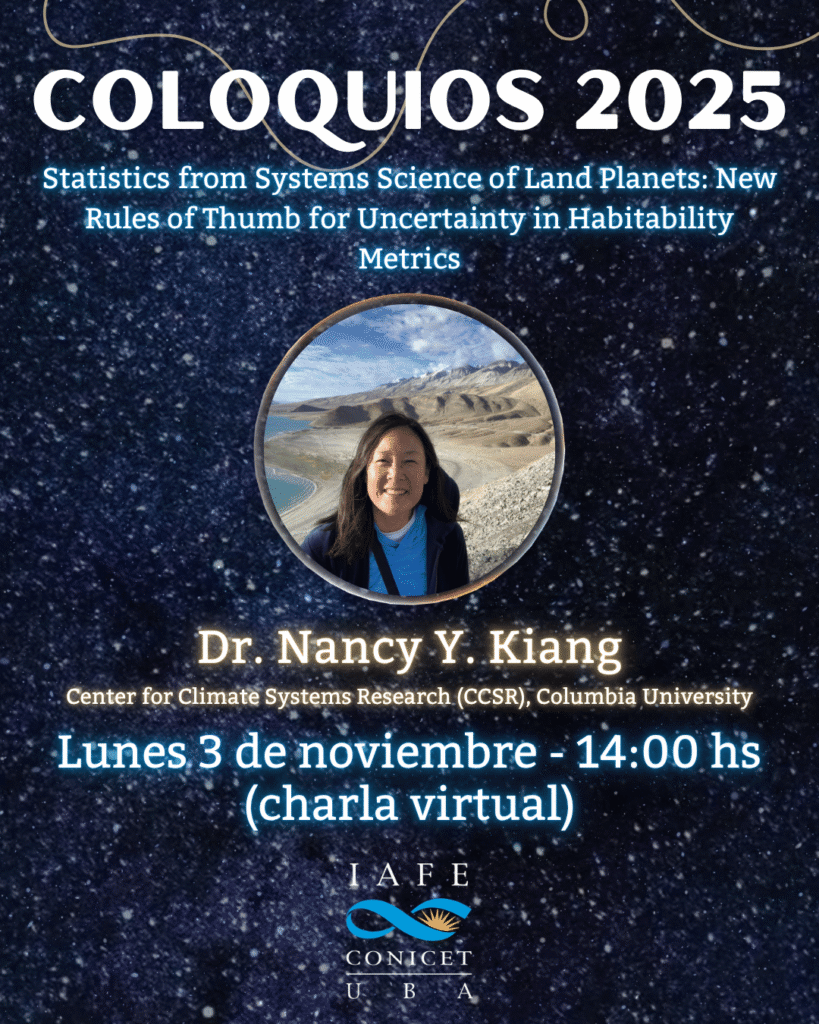Tenemos el agrado de invitarlos al próximo coloquio del Instituto de Astronomía y Física del Espacio (IAFE). El mismo se llevará a cabo el lunes 3/11 a las 14 hs en formato virtual únicamente.
Los esperamos!
Statistics from Systems Science of Land Planets: New Rules of Thumb for Uncertainty in Habitability Metrics
Dra. Nancy Y. Kiang *
Center for Climate Systems Research (CCSR), Columbia University, Nueva York
Resumen:
A systems science understanding planetary climates using 3D general circulation models (GCMs) relies on numerous planetary parameters, only a few of which may be observed by current and upcoming telescope technologies. How do the unknown parameters affect uncertainty in key quantities for constraining planetary habitability? I present statistics of a perturbed parameter ensemble (PPE) of Earth-size idealized all-land planets with flat topography, simulated with the NASA ROCKE-3D GCM. A Latin Hypercube Sampling (LHS) scheme was used to sample from 10 variables to generate a 110-member ensemble varying: stellar temperature, irradiance (hence orbital period), rotation period, obliquity, surface pressure, N2-CO2 atmospheres, surface albedo, surface roughness, soil texture, and initial water content. Generalized additive models were fit to identify non-linear relations between these parameters and prediction of planetary Bond albedo and surface temperature. A suite of multivariate statistical models are presented at different levels of inclusion of all the parameters and select interaction terms, or including only parameters likely to be observed, the stellar type and flux, with uncertainties due to the remaining parameters. The water phase budgets of the planets demonstrate a diversity of climatologies, including persistent liquid water on some synchronously rotating planets; temperature transitions from mostly frozen, to temperate, to steam planets; and longest water lifetimes for planets around hotter stars. This ensemble provides a demonstration of concept to quantify uncertainty for telescope searches for habitable exoplanets. As a characterization of idealized land planets, it provides lessons for future PPE’s needed to span the spectrum of rocky planets that may have also other surface and atmospheric compositions and sizes. The ensemble climatological states will be made available to the community for further analyses that could involve model emulators, machine learning, and observation simulations.
Link a Google Meet: https://meet.google.com/fky-yzvz-doj
PIN: 836 397 404 5260#

*Acerca de la Dra. Nancy Y. Kiang:
Nancy Y. Kiang es biometeoróloga y astrobióloga, su investigación se centra en las interacciones entre la biosfera terrestre y la atmósfera, y el modelado de ecosistemas basado en procesos en Modelos del Sistema Terrestre (ESM) acoplados. Es Investigadora Asociada (Adjunct Research Scientist) en el Centro de Investigación de Sistemas Climáticos de la Universidad de Columbia (CCSR) y miembro de los siguientes equipos del NASA Nexus for Exoplanet System Science (NExSS): el Laboratorio Planetario Virtual (VPL), para el cual investiga la fotosíntesis como señal de vida en exoplanetas; y el equipo ROCKE-3D, para el cual realiza estudios de habitabilidad planetaria a través de simulaciones climáticas. Obtuvo su doctorado en biometeorología y biogeoquímica en la Universidad de California, Berkeley, donde realizó mediciones de campo de los flujos de vapor de agua, energía y CO2 de un ecosistema de sabana de robles de California; ahora simula esta física en modelos globales.
